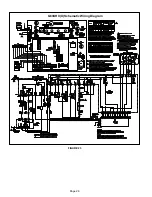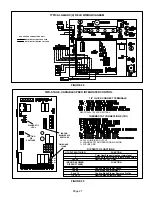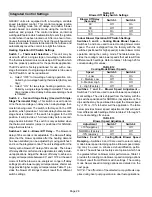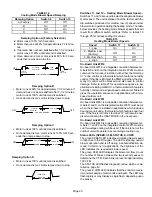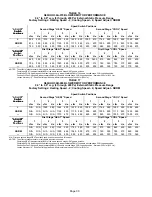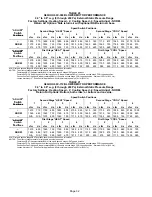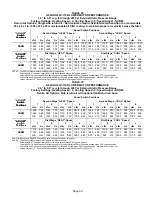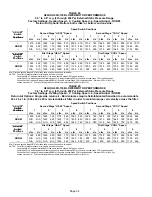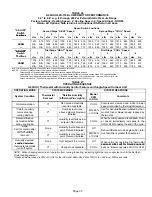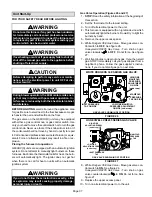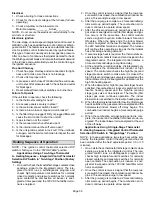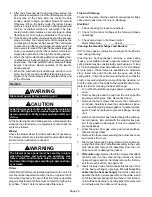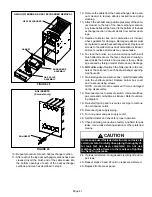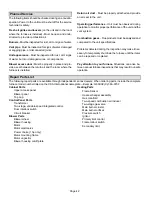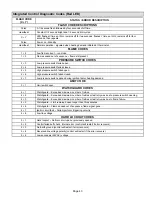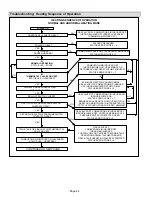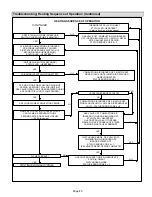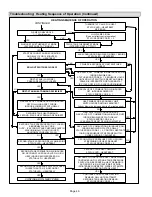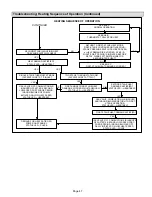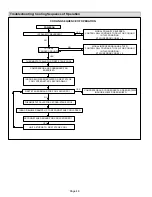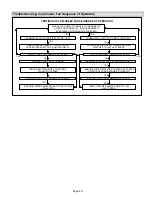
Page 40
4 − After the 20−second warm−up period has ended, the
gas valve is energized on low fire (first stage) and igni-
tion occurs. At the same time, the control module
sends a signal to begin an indoor blower 45−second
ON−delay. When the delay ends, the indoor blower
motor is energized on the low fire heating speed and
the 24V humidifier terminal is energized. The inte-
grated control also initiates a second−stage on delay
(factory−set at 10 minutes; adjustable to 15 minutes).
5 − If the heating demand continues beyond the second−
stage on delay, the integrated control energizes the
combustion air inducer at high speed. The control also
checks the high fire (second stage) pressure switch to
make sure it is closed.The high fire (second stage) gas
valve is energized and the indoor blower motor is en-
ergized for operation at the high fire heating speed.
6 − When the thermostat heating demand is satisfied, the-
combustion air inducer begins a 5−second low speed
post−purge. The field−selected indoor blower off delay
begins. The indoor blower operates at the low−fire
heating speed.
7 − When the combustion air post−purge period is com-
plete, the inducer and humidifier terminals are de−en-
ergized. The indoor blower is de−energized at the end
of the off delay.
Service
WARNING
Disconnect power before servicing unit.
CAUTION
Label all wires prior to disconnection when servicing
controls. Wiring errors can cause improper and dan-
gerous operation. Verify proper operation after ser-
vicing.
At the beginning of each heating season, a licensed profes-
sional service technician (or equivalent) should check the
system as follows:
Blower
Check the blower wheel for debris and clean if necessary.
The blower motors are prelubricated for extended bearing
life. No further lubrication is needed.
WARNING
The blower access panel must be securely in place
when the blower and burners are operating. Gas
fumes, which could contain carbon monoxide, can
be drawn into living space resulting in personal inju-
ry or death.
Filters
All G60UHV(X) filters are installed external to the unit. Fil-
ters should be inspected monthly. Clean or replace the fil-
ters when necessary to ensure that the furnace operates
properly. Replacement filters must be rated for high veloc-
ity airflow. Table 1 lists recommended filter sizes.
Flue And Chimney
Check the flue pipe, chimney and all connections for tight-
ness and to make sure there is no blockage.
Electrical
1 − Check all wiring for loose connections.
2 − Check for the correct voltage at the furnace (furnace
operating).
3 − Check amp−draw on the blower motor.
Motor Nameplate__________Actual__________
Cleaning the Heat Exchanger and Burners
NOTE − Use papers or protective covering in front of the fur-
nace during cleaning.
Cleaning the heat exchanger requires a steel spring
snake," a reversible drill and a vacuum cleaner. The steel
spring snake may be constructed by purchasing a 4 ft. long
by 1/4 inch diameter steel wire cable and a 1/4 inch diame-
ter wire brush. These items are available at a hardware
store. Insert wire end of brush into the open end of the
spring cable. Crimp the cable around the brush so that the
brush is secured and will not come off during cleaning. At-
tach the other end of the cable to the reversible drill to com-
plete the tool for cleaning the heat exchanger.
1 − Turn off both electrical and gas power supplies to fur-
nace.
2 − Remove flue pipe and top cap from the unit. Label the
pressure switch wires, then disconnect them.
3 − Remove the four screws that secure the combustion
air inducer. Carefully remove the combustion air induc-
er to avoid damaging blower gasket. If gasket is dam-
aged, it must be replaced to prevent leakage. See fig-
ure 1.
4 − Remove the collector box located behind the combus-
tion air inducer. Be careful with the collector box gas-
ket. If the gasket is damaged, it must be replaced to
prevent leakage.
5 − Label the wires from gas valve and rollout switches,
then disconnect them.
6 − Remove the four screws securing the burner box cover
and remove the cover.
7 − Disconnect gas supply piping. Remove six screws se-
curing the burner box / manifold assembly to the vesti-
bule panel and remove the assembly from the unit.
Take care not to damage the gasket.
8 −
NOx units only
−
Remove the three screws that attach
the NOx insert to the corbel at the entrance to each
heat exchanger section. Carefully remove the NOx in-
sert from each section. See figure 29.
9 − Insert the brush end of cable snake into the top of one
of the heat exchanger openings.
Do not force the
cable into the heat exchanger.
Insert the cable and
operate the drill on slow speed. Move the cable in and
out of the heat exchanger section three or four times or
until sufficient cleaning is accomplished. Reverse drill
and slowly work the cable out of opening.

